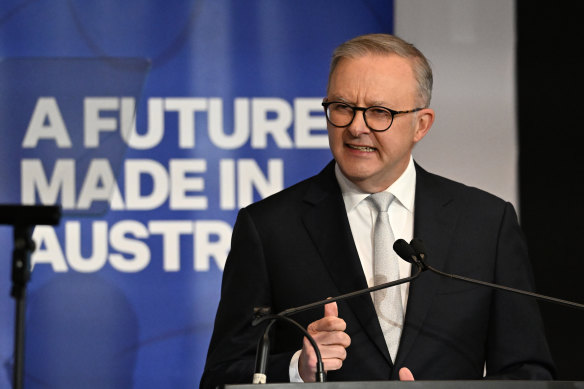
In the mid-year update, Chalmers sliced the forecast size of future budget deficits to $18.8 billion for 2024-25 and $35.1 billion for 2025-26.
Commonwealth Bank chief economist Stephen Halmarick said Chalmers was likely to announce a surplus of between $10 billion and $20 billion for the 2023-24 financial year, which would be a step down from the record $22.1 billion surplus of 2022-23.

Commonwealth Bank chief economist Stephen Halmarick expects a surplus of between $10 billion and $20 billion in the May budget.Credit: Dominic Lorrimer
“At this early stage, the 2024-25 budget is expected to show an improved projected outcome for next year, likely closer to balanced,” Halmarick said.
Chalmers has already signalled the coming budget would contain “significant” investment to bolster the economy, particularly in manufacturing linked to Australia’s transition to renewable energy sources. This week, the government committed $585 million in loans to two critical mineral companies in Queensland and South Australia.
The IMF said Australia’s overall debt, spending and revenue levels were relatively low compared to most other developed nations.
General government gross debt, which reached 57 per cent of GDP in 2020, is expected to edge down to 49.6 per cent this year, on its way to 43.8 per cent by 2029.

Prime Minister Anthony Albanese has pledged a Made in Australia scheme in next month’s budget.Credit: AAP
By contrast, government gross debt in the United States is expected to reach 123.3 per cent of GDP this year; in Britain it is forecast to reach 104.3 per cent; and Canada’s debt is tipped to fall slightly to 104.7 per cent.
But the IMF said government spending across almost all countries was still higher than it was before the pandemic.
It said advanced nations could target the “excessive profits” of companies as part of their corporate tax system, while they should also examine ways to reduce expenditure.
Loading
“Spending pressures to address structural challenges – including demographic and green transitions – are becoming more pressing, while slowing medium-term growth prospects and high real interest rates are likely to further constrain fiscal space in most economies,” the fund said.
“Countries need decisive efforts to safeguard sustainable public finances and rebuild fiscal buffers.”
Chalmers’ spending pressures are exacerbated by the state of the local economy.
Westpac’s leading index, which attempts to track economic growth between three and nine months into the future, edged lower in March and remains negative.
Senior economist Matthew Hassan said Westpac expects growth to remain subdued at just 1.6 per cent this year after it hit 1.5 per cent in 2023.
“While not overly concerning – the index is a long way from the negatives seen when the economy is tipping into a recession – the persistently soft results suggest growth will remain weak over the remainder of the year,” he said.
Chalmers, who left on Wednesday for the IMF meetings in Washington, said he would use the visit to “take the temperature of the economy” to ensure the budget was aligned to current and expected economic conditions.
“So all of this global uncertainty which I’ve described to you is a big influence really – quite a big influence – on the budget as we put the finishing touches on it,” he told ABC radio.



























